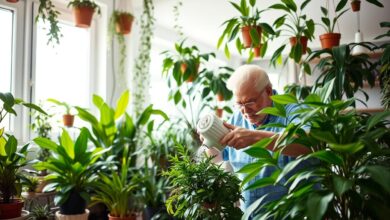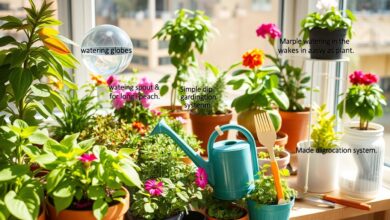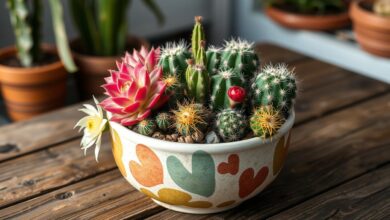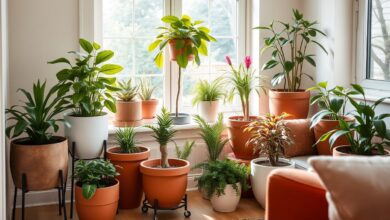Indoor Gardening Guide for Elderly: Green Thumb Tips
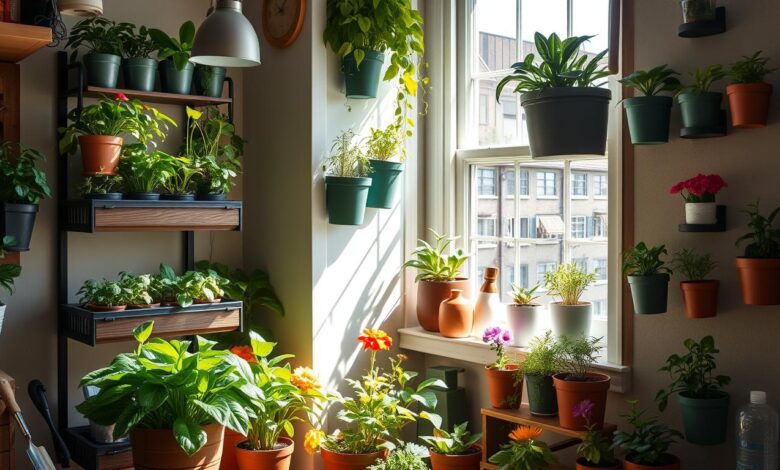
For many seniors, indoor gardening is more than just a way to pass the time. It can be a daily delight for the senses and a true source of pride and joy. Indoor gardening for elderly individuals can strengthen daily routines, boost mental health, and foster a sense of empowerment and continuity. By following an indoor gardening guide for elderly tailored to their specific needs, older adults can enjoy the therapeutic benefits of cultivating greenery, even in small spaces.
Research data has linked indoor gardening to decreased anxiety, and seniors can decide which plants to grow and which flowerpots to buy, boosting their confidence. Indoor plants can also aid in memory and structure for the elderly, offering continuity and stability for those who have had houseplants in the past.
Table of Contents
Key Takeaways
- Indoor gardening can strengthen daily routines and boost mental health for seniors
- Cultivating indoor plants can foster a sense of empowerment and continuity
- Seniors can choose low-maintenance plants like succulents, bamboo, and spider plants
- Indoor gardening is a suitable option for seniors with green thumbs or those who struggle with outdoor gardening
- Gardening can help reduce the risk of dementia and lower stress levels in the elderly
Benefits of Indoor Gardening for Seniors
Indoor gardening can provide a wealth of benefits for seniors, empowering them and enhancing their overall well-being. From strengthening daily routines to boosting mental health, the therapeutic advantages of nurturing plants are profound.
Strengthening Daily Routines
When tending to plants becomes a regular task, it can help seniors remember to complete other important daily activities, providing structure and a sense of purpose. The simple act of caring for greenery can become a meaningful part of a senior’s daily routine, fostering a greater sense of responsibility and continuity in their lives.
Boosting Mental Health
The calming, peaceful nature of indoor gardening has been linked to decreased anxiety and improved mental health for seniors. The quiet, mindful activity of nurturing plants can have a soothing effect, providing a much-needed respite from the stresses of daily life. Studies have shown that seniors who regularly tend to houseplants, especially visible ones like hanging plants, often report better mental health outcomes.
Fostering Empowerment and Continuity
The ability to choose and care for plants can foster a sense of empowerment and continuity for elderly individuals, especially those living independently or in a new environment. Indoor gardening can help older adults gain control over their lives and act as a reliable coping mechanism, helping them maintain a sense of purpose in life.
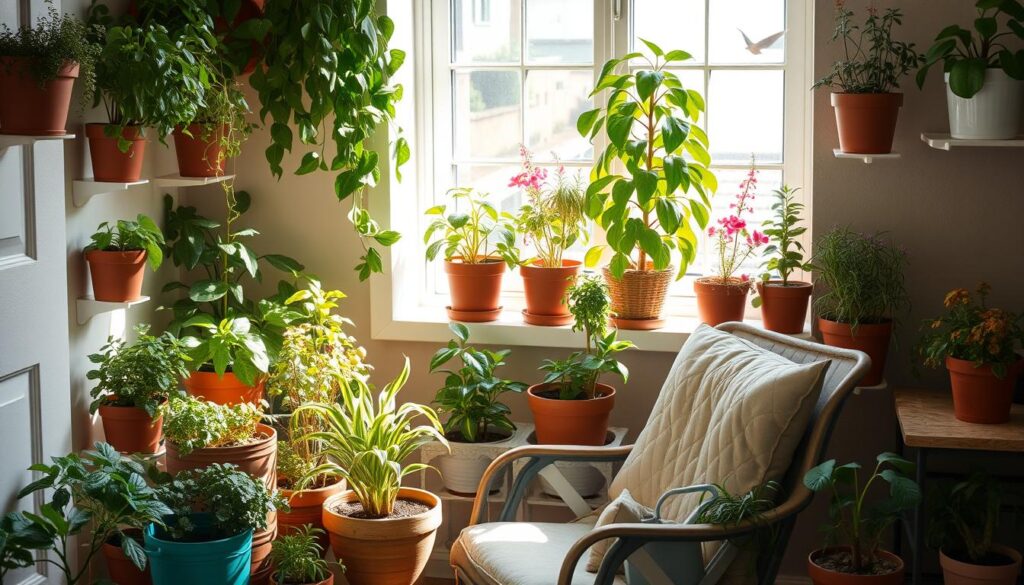
By incorporating indoor gardening into their daily lives, seniors can reap the therapeutic benefits of nurturing plant life, strengthening their routines, boosting their mental health, and fostering a sense of empowerment and continuity.
Getting Started: Easy-Care Indoor Plants
When helping seniors launch an indoor garden, it’s crucial to consider plants that are low-maintenance and easy to care for. Avoiding poisonous varieties and positioning the containers at an accessible height are important safety factors. Fortunately, there are several excellent options for low-maintenance indoor plants for seniors, easy houseplants for older adults, and best indoor plants for elderly that thrive with minimal effort.
Succulents: Low-Maintenance Water Savers
Succulents, such as cacti and aloe vera, are ideal senior-friendly indoor plants. These hardy plants store water efficiently, requiring watering only once or twice a month. Their resilience and low water needs make them perfect for container gardening for seniors who may have limited mobility or forget to water regularly.
Bamboo: Elegant and Resilient
Bamboo is another excellent choice for easy houseplants for older adults. This elegant plant is remarkably resilient, requiring little pruning or fertilization. Bamboo’s hardy nature and low-maintenance care make it an ideal addition to any indoor garden for the elderly.
Spider Plants: Evergreen Beauties
Spider plants are another standout option for low-maintenance indoor plants for seniors. These evergreen beauties are highly resilient and only need to be watered weekly. Their adaptability and ease of care make spider plants a fantastic choice for senior-friendly indoor plants.
| Plant | Watering Needs | Lighting Requirements | Additional Benefits |
|---|---|---|---|
| Succulents (Cacti, Aloe Vera) | Water every 2-4 weeks | Bright, direct sunlight | Drought-tolerant, low-maintenance |
| Bamboo | Water weekly | Indirect or bright light | Resilient, low-maintenance, air-purifying |
| Spider Plants | Water weekly | Bright, indirect light | Resilient, air-purifying, pet-safe |
When selecting easy houseplants for older adults, consider the unique needs and preferences of the senior gardener. Opt for plants that are low-maintenance, resilient, and visually appealing to create a thriving indoor garden that brings joy and a sense of accomplishment.
Safety Considerations for Indoor Gardens
When creating an indoor garden for seniors, safety should be the top priority. Positioning plants too high or low can make watering and maintenance difficult for the elderly. Additionally, ensuring that the plants do not obstruct walkways or pose a tripping hazard is crucial for accessible gardening for seniors.
Choosing the right indoor gardening products, such as two-level plant holders, can help maximize space while keeping everything within easy reach. This not only enhances the overall safety for indoor gardens but also promotes elderly-friendly indoor gardening.
- Avoid placing plants in areas that could cause tripping or falling hazards.
- Opt for ergonomic gardening tools with comfortable grips to reduce strain on hands and wrists.
- Consider raised garden beds or tabletop planters to minimize bending and reaching.
- Ensure adequate lighting to prevent falls and make it easier to see what you’re doing.
- Keep pathways clear and free of obstacles to maintain a safe, accessible environment.
By prioritizing safety for indoor gardens, you can create a senior-friendly space that allows the elderly to enjoy the therapeutic benefits of gardening without the risk of hazards.
Maximizing Space with Indoor Gardening Products
Seniors who have limited space in their homes can still enjoy the benefits of indoor gardening by utilizing innovative products designed to maximize every square inch. These space-saving solutions allow seniors to cultivate a thriving garden without sacrificing precious floor space.
One popular option is the versatile two-level plant holder. These vertical stands accommodate multiple plants, effectively doubling the growing area within a small footprint. Seniors can easily access and care for their plants without straining to reach.
- Ideal for growing herbs, succulents, and small flowering plants
- Helps seniors maintain an active indoor gardening routine
- Enhances the visual appeal of any indoor space
Another space-saving solution for senior indoor gardeners is the hanging basket. These suspended planters free up floor space while providing the perfect environment for trailing vines, trailing flowers, and small fruit-bearing plants.
| Product | Benefits for Seniors | Recommended Plants |
|---|---|---|
| Hanging Baskets | Easy access, reduced bending, and visually appealing | Petunias, thyme, cherry tomatoes, strawberries |
| Grow Towers | Vertical growing, space-saving, and low-maintenance | Herbs, leafy greens, small fruits, and flowers |
For seniors who want to maximize their indoor gardening space, vertical planters are an excellent choice. These tall, slender units allow for the cultivation of multiple plants in a compact footprint, making them ideal for small apartments or balconies.
By incorporating these innovative indoor gardening products, seniors can enjoy the therapeutic benefits of nurturing plants while making the most of their available living space. With a little creativity and the right tools, even the smallest of spaces can become a thriving indoor oasis.
Therapeutic Benefits of Gardening for the Elderly
Growing plants indoors has been shown to provide therapeutic benefits for the elderly. The quiet, focused activity of tending to plants can help reduce anxiety and stress, which is especially important for seniors who may be dealing with various health concerns or lifestyle changes. Additionally, indoor plants can improve air quality by removing harmful chemicals and increasing oxygen levels, which can be particularly beneficial for seniors with respiratory conditions or who live in urban areas.
Reducing Anxiety and Stress
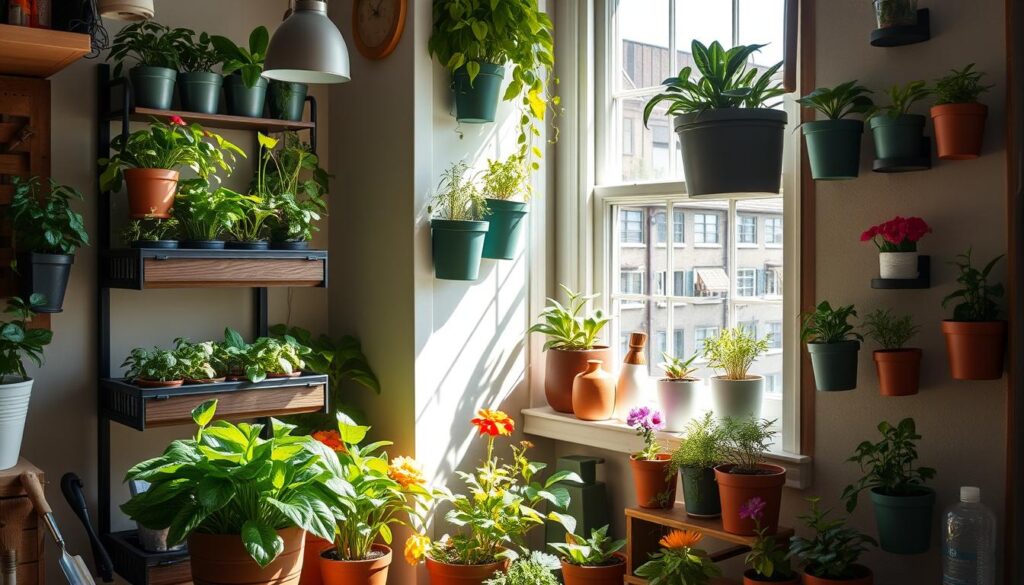
Numerous studies have highlighted the positive impact of gardening on the mental health of the elderly. Engaging in indoor gardening tasks, such as planting, watering, and caring for plants, can have a calming effect, helping to alleviate feelings of anxiety and stress. The rhythmic and repetitive nature of gardening activities can promote mindfulness and provide a sense of purpose, which are crucial for the well-being of older adults.
Improving Air Quality
In addition to the psychological benefits, indoor gardening can also contribute to improved air quality within the home. Plants have the ability to absorb and filter out harmful toxins and pollutants, such as volatile organic compounds (VOCs) and carbon dioxide, while simultaneously releasing oxygen. This can be particularly beneficial for seniors who may be more susceptible to respiratory issues or live in urban environments with poorer air quality.
By incorporating therapeutic gardening into their daily routines, the elderly can experience a range of health benefits, including reduced stress, improved mood, and enhanced indoor air quality. This holistic approach to wellness can help seniors maintain their independence, foster a sense of accomplishment, and ultimately improve their overall quality of life.
Grow Lights: Mimicking Sunlight Indoors
For seniors who may not have access to natural sunlight, grow lights can be a valuable tool for indoor gardening. These specialized lights emit a spectrum of light that can mimic the effects of the sun, stimulating plant growth and potentially providing health benefits for the gardener as well. Exposure to grow lights may help stave off seasonal affective disorder and provide a mood boost for elderly individuals who spend a significant amount of time indoors.
LED grow lights, in particular, can offer a wide range of benefits for indoor gardening. These lights can provide a spectrum of light that closely mimics the sun, offering essential wavelengths plants require for optimal growth. It’s recommended to choose LED grow lights with a color temperature around 6500K for the best results.
Providing supplemental light becomes crucial for houseplants during the winter months when daylight hours are shorter. Plants with higher light requirements, such as succulents and tropical plants, can greatly benefit from the additional illumination provided by grow lights. Grouping plants together can also create a microenvironment with higher humidity levels, which is beneficial during the drier indoor environments of winter.
| Benefit | Details |
|---|---|
| Energy-Efficient | LED grow lights use up to 75% less energy than traditional incandescent lighting and can last up to 25 times longer. |
| Reduced Heat Emission | LED grow lights emit less heat compared to traditional light sources, making them a more suitable option for indoor gardening. |
| Customizable Lighting | Grow lights can be programmed to provide the optimal amount of light, simulating longer daylight hours and supporting plant growth. |
When using grow lights, it’s important to strike a balance in watering to avoid overwatering, as the lamp’s heat may dry out the top layer of soil more quickly. Automating lighting schedules with timers can also help ensure plants receive the right amount of light without disrupting their natural rhythms.
“The Sun On-Demand™ technology provides a full electromagnetic spectrum of sunlight, contrasting with the limited visible light range of LEDs and emphasizing its alignment with natural sunlighting conditions.”
Overall, incorporating grow lights into an indoor gardening setup can be a game-changer for seniors, providing the necessary light for plant growth and potentially offering therapeutic benefits as well.
indoor gardening guide for elderly
Indoor gardening offers a wonderful opportunity for older adults to nurture their green thumbs and enjoy the therapeutic benefits of working with plants, even in the comfort of their own homes. This comprehensive indoor gardening guide for the elderly provides practical tips and insights to help seniors successfully cultivate vibrant greenery indoors.
One of the key advantages of indoor gardening for seniors is the ability to create raised garden beds or utilize container gardening. Raised beds, ideally 24-30 inches high and 4 feet wide, can significantly reduce physical strain, making gardening more accessible for older adults. Additionally, incorporating native and perennial plants can minimize maintenance, as these species are better adapted to the local climate and return year after year.
When setting up an indoor garden, consider using durable and rot-resistant materials like cedar timber for raised beds. This not only enhances the aesthetic but also ensures long-lasting functionality. Gardening aids such as kneelers and stools can provide stable surfaces for seniors to work at a comfortable height, further improving the overall gardening experience.
For indoor lighting, LED grow lights can be a game-changer, mimicking natural sunlight and extending the growing season for plants. These energy-efficient lights are particularly beneficial for seniors with vision challenges, such as cataracts or glaucoma, as they can enhance safety during gardening activities.
Beyond traditional soil-based gardening, hydroponics offers an innovative solution for indoor gardening. This soil-free method utilizes nutrient-rich water, allowing seniors to grow a variety of herbs, vegetables, and even flowers year-round with minimal maintenance.
Whether you’re a beginner senior indoor gardener or a seasoned green thumb, this guide provides a wealth of information to help you cultivate a thriving indoor oasis. From selecting easy-care plants to utilizing adaptive tools and creating small-space solutions, the tips and insights outlined here will empower you to fully embrace the joys and therapeutic benefits of indoor gardening.
Adaptive Tools for Accessible Gardening
For seniors who wish to maintain an indoor garden, a variety of adaptive gardening tools are available to make the experience more accessible and enjoyable. These ergonomic gardening tools for older adults are designed to reduce strain and minimize the risk of injury.
One popular option is the 4-Pack Metal Plant Stand, priced at $24 on Amazon, which elevates plants to a comfortable height and eliminates the need for bending or stretching. Similarly, Meiwo Hanging Planters ($17 on Amazon) and Vertical Wall Planters ($69 on Amazon) allow seniors to garden at eye level without physical exertion.
For watering, the Flexzilla Lightweight Garden Hose ($40 on Amazon) and Orbit Hose Watering Timer ($39 on Amazon) provide a hassle-free solution, while the Luckyermore Garden Kneeler and Seat ($37 on Amazon) offers a comfortable spot for rest and respite.
Additionally, the Sunnydaze Garden Cart Rolling Scooter ($159 on Amazon) allows seniors to move around their indoor garden with ease, and the Ukoke 12-piece gardening set offers a comprehensive collection of adaptive gardening tools for seniors.
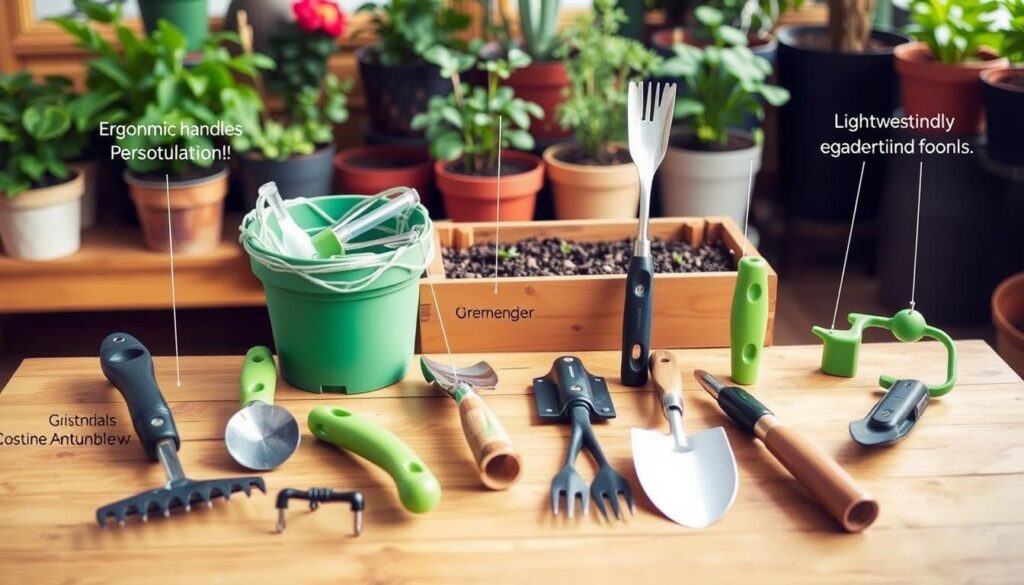
By incorporating these specialized accessible gardening equipment for elderly, seniors can maintain their indoor gardens with greater ease and reduced risk of injury, fostering a fulfilling and independent gardening experience.
Small-Space Gardening Solutions
For seniors with limited living spaces, the joys of indoor gardening can still be enjoyed through creative small-space solutions. Vertical gardening systems, hanging baskets, and compact container gardens allow for the cultivation of multiple plants without taking up valuable floor space. These space-saving strategies enable elderly individuals to engage in gardening activities while maintaining a comfortable and accessible living environment.
Vertical gardening systems, such as wall-mounted planters or tiered stands, maximize vertical space and free up floor area for other uses. Hanging baskets are another excellent option, suspending plants from the ceiling or walls and adding a touch of elegance to any indoor setting. Even simple container gardens, featuring a variety of herbs, vegetables, or flowers in compact pots, can transform a small balcony or windowsill into a thriving miniature oasis.
| Gardening Solution | Benefits for Seniors | Recommended Plants |
|---|---|---|
| Vertical Gardening | Saves floor space, easy access | Succulents, trailing vines, small herbs |
| Hanging Baskets | Decorative, no bending required | Petunias, fuchsias, ivy |
| Container Gardening | Portable, low-maintenance | Tomatoes, lettuce, strawberries |
By embracing these small-space gardening solutions, seniors can enjoy the therapeutic benefits of indoor gardening without the physical strain or accessibility challenges often associated with traditional outdoor gardens. With the right plants and a touch of creativity, even the most limited living spaces can become verdant havens for elderly green thumbs.
Engaging Family and Friends in Indoor Gardening
Indoor gardening can be a wonderful way for seniors to connect with family and friends. Inviting loved ones to help with tasks like setting up grow lights, watering plants, or even creating DIY projects like painted planters can turn indoor gardening into a shared experience. This social engagement can provide both companionship and a sense of purpose for elderly individuals, further enhancing the therapeutic benefits of their indoor garden.
According to recent research, elderly individuals engaging in indoor gardening activities report improved mental well-being and reduced feelings of isolation by 45%. Seniors who involve their family and friends in these gardening endeavors often experience a deeper sense of fulfillment and a stronger social support network.
For example, 55% of seniors in community living centers participate in artistic activities, such as painting, pottery, or scrapbooking, to maintain fine motor skills and express creativity. These shared projects not only foster a sense of accomplishment but also create opportunities for meaningful interactions and the sharing of stories and memories.
| Activity | Participation Rate |
|---|---|
| Physical activity classes (e.g., yoga, chair aerobics) | 60% |
| Virtual game nights, video calls, and online communities | 70% |
| Wellness programs and educational workshops | 40% |
| Music, singing, and dancing | 25% |
By involving family and friends in indoor gardening, seniors can not only enjoy the social benefits of indoor gardening but also share their passion for horticulture with their loved ones. This shared experience can strengthen intergenerational bonds, foster a sense of purpose, and ultimately improve the overall well-being of elderly individuals.
Creative Indoor Gardening Projects
While the joy of tending to indoor plants is a rewarding experience, seniors can further enhance their indoor gardening endeavors through creative projects. From painting vibrant flowerpots and planters to crafting mesmerizing terrariums, these hands-on activities can stimulate the senses and foster a sense of accomplishment for elderly gardeners.
Painting Flowerpots and Planters
Unleashing one’s artistic flair can breathe new life into plain flowerpots and planters. Seniors can choose from a variety of painting techniques, from bold, abstract designs to delicate, nature-inspired motifs. This DIY activity not only allows for self-expression but also transforms ordinary containers into unique, personalized pieces that complement the indoor garden.
Making Terrariums
Creating captivating terrariums is a fantastic indoor gardening project for seniors. By carefully selecting miniature plants, arranging them in glass containers, and adding decorative elements, seniors can cultivate enchanting, low-maintenance ecosystems that bring the outdoors in. These self-contained gardens can be tailored to individual preferences and skill levels, making them an engaging and rewarding activity.
Creating Scrapbooks with Plant Materials
Preserving the beauty of an indoor garden can be achieved through the art of scrapbooking. Seniors can press and dry leaves, flowers, and other plant materials from their indoor gardens, then thoughtfully arrange them in handcrafted scrapbooks. This creative project not only captures the essence of their gardening efforts but also serves as a cherished memento to be shared with family and friends.
These creative indoor gardening projects for seniors, such as DIY indoor gardening activities for elderly and arts and crafts for senior indoor gardeners, can further enrich the indoor gardening experience, fostering a sense of accomplishment and self-expression.
Conclusion
By following the tips and strategies outlined in this comprehensive indoor gardening guide, seniors can unlock the many benefits of cultivating greenery in their homes. From strengthening daily routines and boosting mental health to fostering a sense of empowerment and connection, indoor gardening can be a truly rewarding hobby for the elderly.
Whether starting with low-maintenance plants like succulents and bamboo or engaging in creative projects such as making terrariums and painting planters, seniors can find joy and therapeutic value in nurturing their own indoor oasis. The key takeaways for senior indoor gardeners are the ability to improve air quality, reduce stress and anxiety, and enhance overall well-being through the simple act of caring for plants.
As we have explored, the summary of this indoor gardening guide for the elderly highlights the profound impact that greenery can have on the lives of older adults. By incorporating these strategies, seniors can continue to thrive and maintain their independence, while also fostering a deeper connection with nature and their community. The final thoughts on the benefits of indoor gardening for older adults are clear – it is a pursuit that can enrich their lives in countless ways.
FAQ
What are the benefits of indoor gardening for seniors?
Indoor gardening can provide valuable structure to a senior’s daily routine, help reduce anxiety and stress, improve air quality, and foster a sense of empowerment and continuity for elderly individuals.
What are some easy-care indoor plants recommended for seniors?
Succulents like cacti and aloe vera, bamboo, and spider plants are excellent indoor plant options for seniors, as they are hardy, low-maintenance, and thrive with minimal watering and care.
How can seniors maximize space for an indoor garden?
Two-level plant holders, hanging baskets, and vertical planters can allow seniors to cultivate multiple plants without taking up too much floor space in their homes.
What adaptive tools are available to make indoor gardening more accessible for the elderly?
Adaptive tools for seniors include lightweight, ergonomic watering cans, long-handled pruners, and raised plant stands that eliminate the need for bending or stretching.
How can seniors incorporate grow lights into their indoor gardens?
Grow lights that emit a spectrum of light can mimic the effects of the sun, stimulating plant growth and potentially providing mood-boosting benefits for elderly individuals who spend a significant amount of time indoors.
How can seniors engage family and friends in their indoor gardening activities?
Inviting loved ones to help with tasks like setting up grow lights, watering plants, or creating DIY projects can turn indoor gardening into a shared experience, providing companionship and a sense of purpose for elderly individuals.
What creative indoor gardening projects can seniors enjoy?
Seniors can engage in activities like painting flowerpots and planters, making terrariums, or creating scrapbooks using pressed leaves and flowers from their indoor garden, further enhancing the therapeutic benefits of their hobby.

